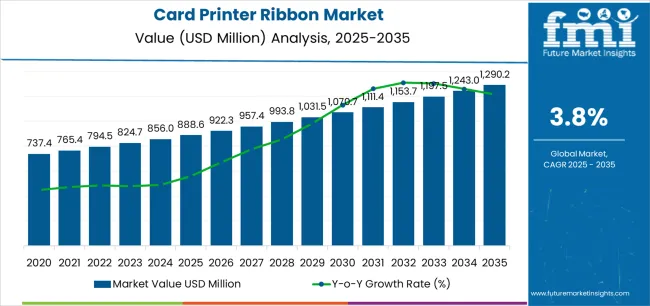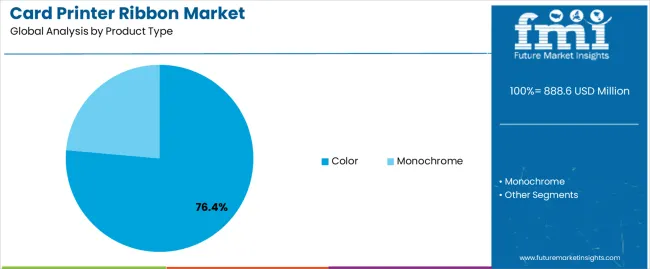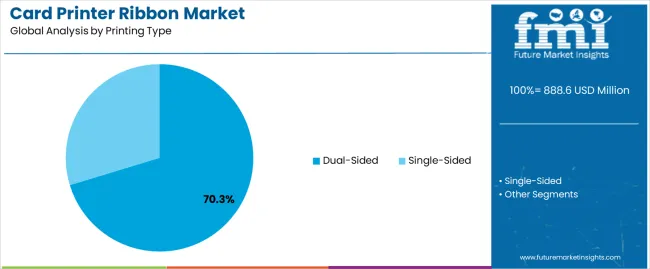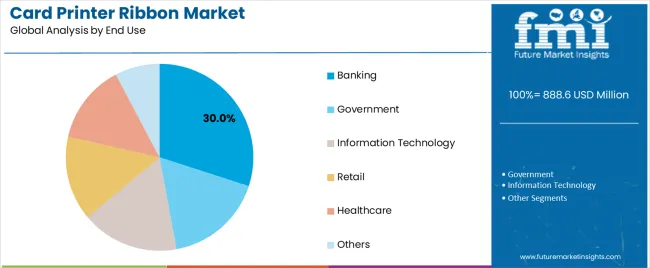The Card Printer Ribbon Market is estimated to be valued at USD 888.6 million in 2025 and is projected to reach USD 1290.2 million by 2035, registering a compound annual growth rate (CAGR) of 3.8% over the forecast period.
The Card Printer Ribbon market is witnessing steady growth driven by the increasing demand for secure and durable card printing solutions across banking, government, and corporate sectors. The market outlook is influenced by the rising adoption of dual-sided card printing technologies, which enable enhanced functionality and higher security features. The growing emphasis on financial security, identity management, and employee access control has further propelled the demand for advanced card printing solutions.
Additionally, advancements in printing technology and ribbon formulations have improved print quality, color vibrancy, and durability, making the solutions more attractive to end users. The banking sector, in particular, has been investing heavily in personalized card issuance and secure transaction solutions, which is boosting the market.
The shift from traditional paper-based systems to plastic and smart cards also supports long-term market expansion Furthermore, increasing integration with digital identity management systems and cloud-based card issuance platforms provides opportunities for innovative solutions, reinforcing sustained growth in the global Card Printer Ribbon market.

| Metric | Value |
|---|---|
| Card Printer Ribbon Market Estimated Value in (2025 E) | USD 888.6 million |
| Card Printer Ribbon Market Forecast Value in (2035 F) | USD 1290.2 million |
| Forecast CAGR (2025 to 2035) | 3.8% |
The market is segmented by Product Type, Printing Type, and End Use and region. By Product Type, the market is divided into Color and Monochrome. In terms of Printing Type, the market is classified into Dual-Sided and Single-Sided. Based on End Use, the market is segmented into Banking, Government, Information Technology, Retail, Healthcare, and Others. Regionally, the market is classified into North America, Latin America, Western Europe, Eastern Europe, Balkan & Baltic Countries, Russia & Belarus, Central Asia, East Asia, South Asia & Pacific, and the Middle East & Africa.

The color product type segment is projected to hold 76.4% of the Card Printer Ribbon market revenue share in 2025, establishing it as the leading type. This dominance is driven by the rising demand for high-quality and visually appealing cards that enhance brand identity and user experience. Color ribbons allow for vivid, full-color printing that meets the requirements of banking, corporate, and government institutions.
The segment’s growth is supported by technological advancements in ribbon coatings and printing precision, which ensure durability and resistance to fading. High adoption of personalization in card issuance, including photo ID cards and membership cards, has further reinforced the prominence of color ribbons.
Additionally, the widespread preference for visually striking cards in security-sensitive applications has made this segment highly attractive The ability to produce secure, customized, and aesthetically appealing cards efficiently continues to drive the color product type segment’s leading position in the market.

The dual-sided printing segment is expected to account for 70.3% of the Card Printer Ribbon market revenue share in 2025, making it the dominant printing type. This growth is attributed to the increasing need for enhanced functionality and data security in cards, as dual-sided printing allows the inclusion of more information and complex designs.
The segment has benefited from the rising adoption of smart cards, ID cards, and loyalty cards that require information on both sides. Dual-sided printing improves operational efficiency by reducing the number of cards needed while offering flexibility for customization.
Technological improvements in printing devices and ribbon materials have further enhanced quality, speed, and reliability of dual-sided printing The segment’s expansion is supported by the growing emphasis on secure and professional card issuance in banking and commercial applications, which continues to reinforce its leading market share.

The banking end-use industry segment is anticipated to account for 30.0% of the Card Printer Ribbon market revenue in 2025, positioning it as the leading end-use sector. This growth is fueled by the increasing need for secure, personalized, and durable banking cards for both customers and employees. Banks are investing in advanced card issuance solutions to support debit, credit, and loyalty card programs that require high-quality color and dual-sided printing.
The segment benefits from the rising adoption of digital banking, which demands secure physical cards as part of integrated identity and transaction systems. Additionally, regulatory requirements and the need for fraud prevention have accelerated the use of sophisticated card printing solutions in the banking sector.
The ability to produce cards that meet security, durability, and aesthetic standards makes the banking sector a major driver of demand for card printer ribbons The ongoing focus on enhancing customer experience and operational efficiency ensures continued expansion of this segment.
The below table exhibits a comparative assessment of the variation in the projected CAGR for the card printing ribbon market over the semi-annual periods spanning from base year (2025) to the current year (2025). The analysis of the compound annual growth rate reveals the vital shifts in the performance of the business and indicates revenue realization patterns.
The examination assists stakeholders in gaining a better understanding of the industry and its growth trajectory over the year. The first half of the year, or H1, spans from January to June. The second half, H2, includes the months from July to December.
Figures presented in the table below showcase the expected CAGR for the card printer ribbon market over the semi-annual period starting from 2025 to 2035. The industry, in the first half (H1), of 2025 to 2035 is expected to surge at a CAGR of 3.3% followed by a spike in growth rate in the second half (H2), where the CAGR is anticipated to be 4.7%.
| Particular | Value CAGR |
|---|---|
| H1 | 3.3% (2025 to 2035) |
| H2 | 4.7% (2025 to 2035) |
| H1 | 4.5% (2025 to 2035) |
| H2 | 3.5% (2025 to 2035) |
Shifting to the subsequent period, from H1 2025 to H2 2035, the CAGR is projected to decrease slightly to 4.5% in the first half (H1) and further fall to 3.5% in the second half. In the first half (H1) the industry witnessed a decrease of 20 BPS while in the second half (H2), the industry witnessed an increase of 10 BPS.
Focus on Secure Access Control Boosts the Need for Advanced Card Printing Solutions
Growing focus on fraud prevention and a secure approach to accessing controls has increased demand for advanced card printing solutions in the banking sector. The industry requires durable and safe identification cards, driving demand for card printer ribbon.
In an era where identity theft, cybercrimes, and unauthorized access are on the rise and pose a significant threat to banks worldwide, financial institutions are increasingly pursuing security. In response to these vulnerabilities, banks have turned to investing in impressive card printing machines that have additional safety features while being durable.
Growing Implementation of ID Cards in the Manufacturing and Construction Sectors
The card printer ribbon business is primarily driven by the increasing adoption of identity cards, coupled with security requirements, improved productivity, and regulatory compliance in the manufacturing sector. The intricacy and interconnectedness of facility communications require robust identity cards and access control mechanisms.
Security is a key concern for companies in the construction industry. This is because they have to protect intellectual property, sensitive information, and physical assets. They are set to achieve this through the use of ID cards that only allow authorized personnel to enter work sites of specific areas.
Modern ID cards are made of high-quality card printer ribbons and incorporate various security features such as radio frequency identification chips (RFID), biometric data, or encrypted information. These features prevent unauthorized access, provide security, and ensure compliance with all protocols to reduce the risk of theft, sabotage, or technical espionage.
ID cards also contribute to increased operational efficiency across organizations. In large-scale manufacturing plants, it is important to have a system that keep track of employee movements, manage attendance and regulate access to different points within the organization. This allows for record keeping of automated time-sensitive zones with simplified entry via badges.
Growing Demand for Ribbons Compatible with RFID and NFC Technologies
Growing preference for contactless cards in the banking and retail sectors has significantly increased demand for card printer ribbons that are compatible with RFID (Radio Frequency Identification) and NFC (Near Field Communication) technologies. Banks and other financial institutions are issuing contactless credit and debit cards, leading to an increasing need for advanced card printer ribbons capable of embedding RFID and NFC technologies.
Consumers and businesses who prioritize convenience, speed, and security in transactions have embraced contactless cards. This trend is driven by the extensive use of RFID and NFC technologies as they facilitate quick, secure and hands-free transactions.
The global card printer ribbon market size was USD 737.4 million in 2020. The sector grew at a CAGR of 4.8% from 2020 to 2025. The industry size was valued at USD 888.6 million in 2025.
The global card printer ribbon industry witnessed steady growth due to growing demand from banking, retail, healthcare, and government sectors. The historical period witnessed an increasing emphasis on secure identification solutions and the proliferation of plastic cards for several applications.
Ongoing digitization of economies has raised the use of plastic cards for e-payment systems. This is expected to drive the business for secure identification solutions. Growth of e-commerce, fintech, and the healthcare sectors is set to amplify demand for personalized plastic cards for access control, payment applications, and identification.
Online businesses are giving rewards in the form of loyalty cards and prepaid cards to lessen the burden of the payment process. Card printer ribbons utilize thermal technology and ribbon cartridges, relying on external computers without Programmable Logic Controllers (PLCs). This new technology offers high-quality ID cards with crisp detailing, influencing industries like banking, and manufacturing, thereby boosting the application of card printers and consumables.
The card printer ribbon market forecast projects the industry to reach a value of USD 888.6 million in 2025. It is expected to grow at a CAGR of 4% throughout the forecast period to reach a size of USD 1290.2 million by 2035.
Tier 1 companies comprise leaders with a revenue of around USD 100 million. They capture a significant share of 15% to 20% in the global market. These companies are characterized by high production capacity and an extensive product portfolio.
Businesses in Tier 1 are distinguished by huge expertise in manufacturing and reconditioning across multiple packaging formats and a broad geographical reach, supported by a sizable customer base. They provide a variety of services including reconditioning, recycling, and manufacturing and utilize the latest technology in their production processes.
Tier 1 companies are set to ensure regulatory standards in their manufacturing, providing the highest quality product. Prominent companies within Tier 1 include Zebra Technologies Corporation, Dai Nippon Printing Co., Ltd. ASSA ABLOY AB, Entrust Datacard Corporation, Kanematsu USA Inc.
Tier 2 is made up of mid-sized companies with a revenue of USD 50 to 100 million. They have presence in specific regions and a high influence on the local economy. Organizations in tier 2 are characterized by a strong presence overseas and robust knowledge.
Tier 2 companies may not have advanced technology and a wide global reach but they have access to good technology and ensure regulatory compliance in their processes. Renowned companies in Tier 2 include Evolis S.A., Matica Technologies AG, NBS Technologies Inc., Magicard Ltd.
The section offers businesses with an overview of the industry on a country-by-country basis. It comprises a detailed examination of the emerging trends and opportunities in the sector. This country-specific examination of the dynamics of the industry is likely to help companies understand the complex nature of the sector.
The analysis contains key factors, potential challenges, and forecasts impacting demand, production, and consumption of product within each country. This section aims to help companies make informed decisions and develop effective strategies tailored to individual countries.
Türkiye is expected to emerge as a dominating country in the business during the forecast period with an estimated CAGR of 6%. South Korea, Spain, and China are projected to follow behind Türkiye to become one of the leading countries with projected CAGRs of 5.1%, 4.9%, and 4.3%, respectively.
| Countries | CAGR 2025 to 2035 |
|---|---|
| Türkiye | 6% |
| South Korea | 5.1% |
| Spain | 4.9% |
| China | 4.3% |
| United States | 3.4% |
Sales of card printer ribbons are driven by technological advancements, increased demand for secure identification cards, and growing environmental awareness. Manufacturers are developing ribbons that offer higher durability, improved print quality, and compatibility with various card materials in the United States.
Demand for eco-friendly solutions is also growing, with manufacturers developing biodegradable materials or those that reduce waste during production and usage. Additionally, the integration with smart card technologies, such as RFID and NFC-enabled cards, is a corresponding demand in the country. This trend is expected to continue as organizations in the United States prioritize security measures and adopt eco-friendly solutions.
South Korea, similar to other developed countries, has an increasing requirement for secure identification solutions. This results in an elevated demand for ID cards and access badges that require ribbons for printing. The country has a rising popularity for contactless smart cards, driving demand for card printer ribbon.
Shift toward chip-based cards having enhanced security features necessitates the use of compatible ribbons for card printers. Growing preference for personalized cards is further set to surge sales of card printer ribbon in South Korea. Leading companies are increasingly using plastic cards for business promotion, thereby raising demand for car printer ribbons.
Businesses are increasingly seeking card printer ribbons for customization and personalization, particularly in sectors like education, healthcare, and events. The card printer ribbon market in Türkiye is experiencing competition from local suppliers and international manufacturers, encouraging innovation and price competitiveness.
Compliance with industry standards, particularly regarding card durability, security features, and environmental impact, is influencing product development and market dynamics. Government in the country is progressively promoting domestic production by providing local companies with attractive incentives, thereby driving growth of the business.
The below section provides companies with insightful data and analysis of the two leading segments of the target sector. Segmentation of these categories helps organizations understand the dynamics of the sector and to invest in the beneficial zones.
Examination of the growth of the sector enables organizations to obtain a thorough understanding of the trends, opportunities, and challenges present in the business. This analytical data is likely to help businesses in navigating the complex business environment and make informed decisions.
In terms of product type, color segment is set to dominate the business with a value share of 76.4% in 2025. Dual-sided printer is emerging as the leading printing type with a value share of 70.3% in the same year.
| Segment | Color (Product Type) |
|---|---|
| Value Share (2025) | 76.4% |
The color segment is dominating the card printer ribbon market primarily because of its versatility and aesthetic appeal. Colors allow all bright and colorful graphics, logos, and images to be easily printed on cards, making them attractive and appealing. The aesthetic appeal of loyalty cards, membership cards, and event badges significantly impacts brand perception and customer engagement in industries like retail, hospitality, and events.
Detailed graphics, color inlays, and holographic images that enhance ID card security and functionality are examples of color printing items used in banking, healthcare, and government sectors. Companies are seeking customized cards that accurately reflect their brand, with colors allowing for striking replication of colors, logos, and graphics, ensuring alignment with branding guidelines.
| Segment | Dual-sided (Printing Type) |
|---|---|
| Value Share (2025) | 70.3% |
The dual printing segment dominates the card printing ribbon market primarily because of its ability to provide detailed and improved card performance. With dual-sided printing, a single card can have a staggering amount of information without it looking excessive. The use of dual-sided cards in healthcare, government, and corporate environments allows for clear display of personal information, barcodes, magnetic stripes, and security features.
Security is a key concern for organizations, especially in banking, government sector and corporates. Dual-sided cards provide additional space for advanced security features such as holograms, watermarks, micro text, and encoded data, which can be split on two sides. This makes it harder for counterfeiters to copy the cards, increasing overall safety.

Key companies in the industry including Zebra Technologies Corporation, Evolis S.A., ASSA ABLOY AB, Dai Nippon Printing Co., Ltd., and HiTi Digital, Inc. Leading companies are investing in advanced reconditioning facilities and entering into partnerships.
Companies are progressively acquiring smaller companies to grow presence and further penetrate the reconditioned sector across multiple regions. Trends toward ecologically friendly products, as well as increased usage of digital printing technology, are significantly impacting the dynamics.
Manufacturers are working toward incorporating features such as biometrics and holograms to make the cards extra secure. The sector is witnessing an increasing adoption of cloud-based technologies as they require less maintenance and are easier to operate.
Manufacturers are emphasizing production procedure cost-effective which will likely enable them to have competitive pricing in the global sector, thereby giving them a competitive edge. Companies differentiate themselves in the landscape through product quality, printer compatibility, and value-added services.
Competition in the business encourages continuous progress and innovation to cater to the evolving demands of consumers. Manufacturers are investing in research and development activities to develop and innovate new and enhanced products.
Organizations are emphasizing improved efficiency and workflow management. They are seeking ways to increase productivity, asset utilization, and provide better customer experiences. Local and regional vendors are offering precise application products for several end use industries. Companies are adopting innovative methods and focusing on product launch. They are widening their footprint through geographic growth.
Industry Updates
Based on product types, the sector is divided into color and monochrome.
By printing types, the segment is categorized into single-sided and dual-sided.
Card printer ribbon has applications in banking, government, information technology, retail, healthcare, and others.
The sector is spread across North America, Latin America, Western Europe, Eastern Europe, East Asia, South Asia, Oceania, and the Middle East and Africa.
The global card printer ribbon market is estimated to be valued at USD 888.6 million in 2025.
The market size for the card printer ribbon market is projected to reach USD 1,290.2 million by 2035.
The card printer ribbon market is expected to grow at a 3.8% CAGR between 2025 and 2035.
The key product types in card printer ribbon market are color and monochrome.
In terms of printing type, dual-sided segment to command 70.3% share in the card printer ribbon market in 2025.






Full Research Suite comprises of:
Market outlook & trends analysis
Interviews & case studies
Strategic recommendations
Vendor profiles & capabilities analysis
5-year forecasts
8 regions and 60+ country-level data splits
Market segment data splits
12 months of continuous data updates
DELIVERED AS:
PDF EXCEL ONLINE
Cardiac Rehabilitation Market Size and Share Forecast Outlook 2025 to 2035
Cardiology Information System Market Size and Share Forecast Outlook 2025 to 2035
Cardiopulmonary Functional Testing Platform Market Size and Share Forecast Outlook 2025 to 2035
Cardiovascular CT Systems Market Size and Share Forecast Outlook 2025 to 2035
Cardiac Monitoring And Cardiac Rhythm Management Devices Market Size and Share Forecast Outlook 2025 to 2035
Cardiovascular Surgical Devices Market Size and Share Forecast Outlook 2025 to 2035
Cardiovascular Devices Market Size and Share Forecast Outlook 2025 to 2035
Cardiac Rhythm Management Devices Market Size and Share Forecast Outlook 2025 to 2035
Cardiac Valvulotome Market Size and Share Forecast Outlook 2025 to 2035
Cardamom Oil Market Size and Share Forecast Outlook 2025 to 2035
Cardiovascular Prosthetic Devices Market Size and Share Forecast Outlook 2025 to 2035
Cardiac Ambulatory Monitoring Market Size and Share Forecast Outlook 2025 to 2035
Carded Packaging Market Size and Share Forecast Outlook 2025 to 2035
Cardiometabolic Drugs Market Size and Share Forecast Outlook 2025 to 2035
Cardboard Flask Market Size, Share & Forecast 2025 to 2035
Cardboard Crates Market Size and Share Forecast Outlook 2025 to 2035
Cardiac Rhythm Remote Monitoring Devices Market Size and Share Forecast Outlook 2025 to 2035
Cardboard Trays Market Size, Share & Forecast 2025 to 2035
Cardiovascular Ultrasound Market - Demand & Innovations 2025 to 2035
Cardiac Ultrasound Systems Market - Trends & Forecast 2025 to 2035

Thank you!
You will receive an email from our Business Development Manager. Please be sure to check your SPAM/JUNK folder too.
Chat With
MaRIA